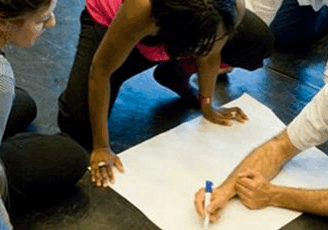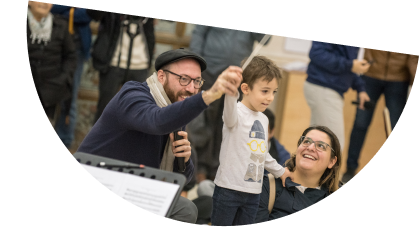In 2008-2009, RESEO and its members organised the Creative Residencies Project.
A Creative Residency is the name for a process in which artist-animateursand participants, often young people, devise a new work. Launched in May 2008, the Creative Residencies Project (CRP) empowered a new generation of artist-animateurs with the skills to devise opera with a wide variety of participants in creative residencies and – without compromising on the highest artistic standards – put the creation of opera within the grasp of ordinary citizens. A diverse set of nine co-organisers collaborated to produce a series of five creative residencies, built on a common theme: ‘different forms of modern slavery’.
These residencies were a training opportunity for artist-animateurs from varied artistic backgrounds to harness the potential of every individual’s creativity. Devising opera through participation in this way also challenges traditional notions of opera and brings the art form into dialogue with other artistic disciplines. The project offered multiple opportunities for the citizens of Europe to ‘get to grips’ with this living art form: directly – through some of the creative residencies; indirectly – through a film and publication; and through the media coverage of the high-profile residencies, taking place at some of the most prestigious cultural events/institutions in Europe.
Aims of the project
• To develop, through genuine European transnational collaboration, the practice of creative residencies as a means of involving non-professionals in the making of opera.
• To train and stimulate animateurs from diverse artistic backgrounds, through a shared exploration of a common theme, to find new ways of engaging different publics with ways to (create) opera.
• To raise the profile of devised opera, showing that opera a living, relevant European artform, open to new influences.
• To show how creative residencies are a means through which citizens of Europe can explore their own creativity, languages and common cultural heritage.
“Artist-animateur” is a term for an artist, of any discipline, working in an education context.
RESEO published a document on the Creative Residencies project, with feed back from participants. If you are interested, please send us a mail (reseoATreseo.org).
Dates
29-31 May 2008, Bregenz, “The artists meet”
13 artists-animateurs from 5 countries come together for 2,5 days to explore the theme of modern slavery.
The participants, led by Aleksandra Vohl, John Barber and James Redwood, created a performance piece responding to the theme, but also displaying to the RESEO members attending the conference the possibilities of creation by disparate groups with complementary talents. The aim was to empower a group of artist-animateurs with new skills to enable them to engage “ordinary people” with opera.
22-23 September 2008, London, “New horizons, the visual arts”
London’s contribution to the Creative Residencies Project had two parts. On the first day, a class of primary school pupils worked at the National Portrait Gallery with animateurs from the gallery and from Music Platform. They were observed by and in some cases worked alongside the artist-animateurs who would repeat the process the following day with a different group of pupils.
This creative residency in London was different from the one that had taken place in Bregenz. There, over two days, a group of artists had created an operatic work in response to a theme. The London residency introduced two other elements : a museum and children as participants. The aim was to create a workshop and to give the visiting artists techniques for working across art forms and for working with and inspiring children’s creativity. Practitioners first observed and participated with the pupils and then led a creative residency of their own.
The workshop was led by Peter Letanka.
13-14 November 2008, Amsterdam, “Engaging with managers”
Amsterdam hosted two concurrent creative residencies, both designed for RESEO members.
The first residency, led by Rachel Leach and Tim Yealland, was called “From Street to Street” and used slavery in Europe today as starting-point. Its objective was to demonstrate ways in which very strong work can be generated quickly and effectively in groups of people of very different levels of experience and skill, giving structures which can be used to give anyone an equal and valid artistic voice, leading to the creation of a short opera over two sessions.
“Voices form the Underbelly”, the second residency on the theme of people trafficking, was led by Carlo Scheldwacht and was based on Berthold Brecht’s style of “epic theatre” in which the actor tells a story rather than inhabits a role, in a process of “narrative theatre”. Participants were invited to explore different characters, voices, perspectives, motives and attitudes and to use different theatrical forms to tell the stories from the viewpoints of different characters.
12-14 February 2009, Stockholm, “New horizons, dance”
The residency was led by three experienced artists: director, Karen Gillingham, composer Hannah Conway and choreographer Gunnlaugur Egilssson. The participants devised an original opera from scratch in three days, using modern day slavery as their starting point. Participants explored themes such as exploitation, conscience, entrapment and co-dependence through physical movements, dramatic improvisations and vocal composition.
The piece was formed directly from participants’ own perceptions, experiences and responses. The residency enabled participants to continue their own professional development and projects with renewed inspiration and ways of working. The piece devised has been performed on the last afternoon of the residency to a small invited audience.
The residency provided an opportunity for performers to work with artists who regularly create and devise their own work, challenge traditional notions of operatic form and are passionate about education.
16-19 April 2009, Barcelona, “European Opera Forum”
During the European Opera Forum, which took place from 17th to 19th of April, RESEO ran two Creative Residencies for the young participants as the culmination of a year’s work. The two days Barcelona Residencies were open to young Europeans aged 18 – 25, mostly sponsored by opera houses, giving them the opportunity to take part in the workshops. After these two day’s work (improvisation and lyrics creation, music, devising, body movement), an extract of their work was presented to delegates on Saturday 18th.


